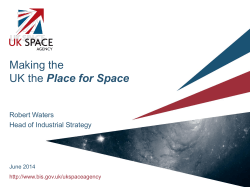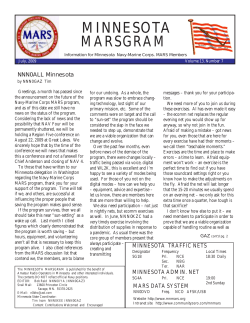
Satellite Power Systems TECHNOLOGY PROGRAMMES Solar energy used in space BR-202
BR-202 May 2003 TECHNOLOGY PROGRAMMES Satellite Power Systems Solar energy used in space TECHNOLOGY PROGRAMMES INTRODUCTION The success of a space mission is always linked to the performance of technology. To have a technology ready when a satellite flies, research and development must start years in advance. This is the objective of the Technology Programmes of the European Space Agency: to ensure effective preparation for European space activities. Solar cells are a good example of space technology. This brochure gives you many examples of how they work on a spacecraft, and what challenges they must overcome. I hope it will let you share the enthusiasm of the engineers who wrote the stories. Above all, I hope it will help you to appreciate the efforts of all those European engineers who work behind the scenes on space projects, not only in the area of solar cells, but also in many other fields. Without their hard work, Europe’s success in space would not have been possible. Niels E. Jensen Head of the Technology Programmes Department SATELLITE POWER SYSTEMS Solar power Every life form or machine needs energy to function Nothing can change its state or position without energy. Just like many other machines, satellites also need electrical power to function. When one is out in space, however, the problem is where to get that power from. Here on the ground there are many ways to produce The Sun is electrical power - or rather to transform some other form of energy into electricity. If you are at sea or on top of a mountain, for example, a very powerful, clean and convenient you can use portable generators or batteries. The Sun is a very powerful, clean and convenient source of power, particularly for satellites. The only thing needed is a means to source of power, convert the energy contained in the Sun’s radiation – mainly light and ultraviolet rays – into electrical power. The most efficient way to particularly for satellites achieve this today is by using panels composed of semiconductor photovoltaic cells.‘Solar panels’, as they are usually called, are now quite a common sight here on Earth, but they were first used in space in 1958 to power the ‘Vanguard’ satellite. In real photovoltaic cells, such as the Hubble Space Telescope silicon solar cell shown here, the basic materials, the doping and the shape of the junction are chosen in such a way as to increase their capability of transforming the light energy into electrical energy. Each cell is capable of producing a small amount of current at a relatively low voltage, more or less like a common pen-light battery. Many of them have to be combined in series to produce the amount of electric power needed for a satellite to function and to meet the power demands of its on-board instruments. How do solar cells work? Each one of the thousands photovoltaic cells to be found in a solar panel is made of a semiconductor material, mostly silicon, capable of converting the light arriving from the Sun into an electrical current. This is exactly the reverse of what happens in any of the thousands light-emitting diodes (LEDs) to be found on the front panels of almost all of today’s electronic equipment. Semiconductors like silicon are rather strange materials. They are normally insulators, which means that an electric current cannot pass through them, but it is possible to change crystals made of these materials into conductors by applying a sufficiently high voltage to them. What A silicon solar cell from the NASA-ESA Hubble Space happens is that the voltage applied across the material Telescope. Such cells have an operating efficiency of pulls electrons orbiting the atoms of the crystal out of their about 14% orbit, making them available to become part of an electric current flowing through the material. This can be interpreted as the voltage applied to the crystal making the electrons jump the barrier that constrains them to orbit around each atom. SEMICONDUCTOR MATERIAL Two or more layers of semiconductors with different dopings (p/n junctions) have slightly different conductivity characteristics. They are used to build devices capable of controlling the current flow. Each junction creates a barrier, similar to that present in the crystal itself, but with the desired behaviour. The most fundamental characteristic of a semiconductor p/n junction is that electrons can jump it very easily only in one direction. When the junction is illuminated, a portion of the light’s energy is transferred to electrons in the materials, making them jump the barrier as if a voltage had been applied to it. If there is a circuit, maybe just a piece of metallic wire attached to the other end of the crystals forming the junction, then the electrons will flow through it, returning to where they started from. An electric current, generated by what is a very basic photovoltaic cell, flows through the circuit. The capability of semiconductor crystals allowing or not the flow of electric currents through them can be reinforced by adding controlled quantities of properly chosen chemical elements. The process, called ‘doping’, produces crystals with more (n-type) or fewer (p-type) electrons available to be freed when a voltage is applied. Why are solar arrays so large? When the Sun is far away? A good example of a mission deep into space is ESA’s ‘Rosetta’ project, which will rendezvous with Despite the strength of the Sun, the solar and land on a comet after travelling through space for almost eleven years. In this case, the silicon arrays needed by an average-sized satellite solar cells have to be specially designed to cope with the very low temperatures and very low light are quite large, due to the rather low levels that Rosetta will have to endure during its journey. Consequently, this spacecraft’s solar efficiency of the individual solar cells. arrays remain impressively large. This is why most pictures of classical satellites show a pair of long wings extending from their sides, which are the ‘solar panels’. More modern solar cells based on semiconductor materials like gallium-arsenide/arsenium are now becoming available, with efficiency figures nearly double those of silicon cells.These new types of cells will allow smaller solar arrays to be used on future space missions. SOLAR POWER NUNA ‘Nuna’, a record-breaking solar-powered racing car The power-system technologies developed for ESA’s spacecraft have been embodied in many exciting projects back on Earth in recent years. This has included an entry in 2001 in the ‘World Solar Challenge’, a race for solarpowered cars from Darwin to Adelaide in Australia, a distance of 3010 km. The winner in 2001 at its first attempt was the Dutch car ‘Nuna’, which exploited European space power-system knowhow and technologies. Thanks to this unique support from ESA, the car established a new World Record time of 32 hours 39 minutes. The team was led by an ESA astronaut, now Head of the ESA Education Office, Wubbo Ockels. The European space power-system technologies used to give the ‘Nuna’ car its winning edge The International Space Station (ISS) orbiting the Earth, in December 2001 (photo NASA) What happens when the Sun is hidden? Solar power generation is very convenient in space, especially because there are no clouds and the Sun never sets. Or does it? Satellites orbiting the Earth pass through a shadow region on the opposite side of the Earth from the Sun. Depending on the type of orbit, this can happen just a few times a year or every few hours. During these so-called ‘eclipses’, the solar panels cannot produce electrical energy and the satellite would not only be unable to operate, but would also freeze to incredibly low temperatures (eventually around –270°C) if a backup power source were not available. Electrical energy therefore has to be stored onboard the spacecraft when in sunlight for consumption during these eclipses. There are essentially two ways of storing electrical energy that are used on satellites, both of which rely on reversible chemical reactions. One is based on cells very similar to those found in portable phones and other equipment with International Space Station The International Space Station has solar panels rechargeable batteries.The other uses so-called ‘fuel cells’, a type of electrical accumulator now being used experimentally in cars and buses. comparable in span to the size of a football pitch in order to generate an impressive 92 kW of power – the largest solar arrays in orbit to date The basic principle is the same. An electric current passing through the cell causes a pair of substances to combine into a new chemical composite transforming electrical energy into chemical energy. This charges the accumulator, storing the electrical energy being delivered to it. When the Using the energy accumulator is then inserted into an electrical circuit containing a load, it will Using the energy produced by the solar panels or produce a current, gradually releasing its charge: the chemical composite retrieved from the accumulators requires the use of splits back into its two components, generating a steady flow of electric sophisticated electronic devices, called ‘power- charges (an electric current) through the circuit. conditioning units’. However, it is not possible for most of the equipment aboard the satellite to be Rechargeable batteries use solid substances that are easily packaged directly connected to them. Many ESA satellites like into housings of various shapes. Car batteries also need water, very pure the Rosetta mission, therefore, utilise small devices water, since the substance they use to the store energy, namely sulphuric that guarantee optimal balance between the power acid (highly corrosive, which is why you should never open one of them!), has from the battery and the power from the solar to be dissolved for the battery to work. Unlike a battery, fuel cells generate arrays, even under unfavourable conditions of current rather than simply storing energy. This is achieved by combining eclipse and low-incidence illumination. These very hydrogen and oxygen at a platinum membrane, with water as a by-product. advanced devices are called ‘Maximum Power This water can also be accumulated in a tank and successively divided into Point Trackers’. oxygen and hydrogen by electrolysis, i.e. by letting a current flow through it. The technology of space exploration Satellites Antennas are only one of the many kinds of technology developed for satellites and space missions. What is space technology all about? Why are satellites as they are? Satellites can generally be regarded as spacecraft that receive signals and send them back to Earth. However, these spacecraft are extremely complex and expensive – each one costs millions of Euros – because they have to work and survive in space for periods of up to 15 years. To make this possible, a satellite has to produce its own power, generating electricity from sunlight falling on photovoltaic cells or solar panels. Batteries are used to store the energy, so that the satellite can continue to work when the Sun is eclipsed or far away – for example during a mission to visit a comet or a distant planet. To position itself in space, a satellite has to manoeuvre using its own small rocket engines. It also has to maintain its orientation, using thrusters or gyroscopes, otherwise it will tumble along its orbit and its antenna will drift out of alignment with the Earth. Space is not a friendly environment either. Satellites have to survive temperature variations of more than 200°C – rather like someone standing in front of a fireplace with a blazing fire while an air conditioner pumps freezing air onto his back. Outside the protection of the Earth’s atmosphere, the level of radiation (UV, X-rays, gamma-rays and all sorts of energetic particles) is much higher and more destructive than on the ground. Before they can even begin to operate in space, satellites have to survive the bone-shaking launch. Then the solar panels have to be opened and antennas, which are often stowed to take less space in the launcher, deployed before the satellite enters its operational orbit. Once in orbit, a satellite usually carries out multiple functions, with different payloads or instruments. It then sends information to a ground station about the condition of its payload and its systems, and it receives instructions back from the ground operators. All this has to work well, with little possibility of recovery, not to mention repair. Apart from very special cases, there is no way back. Unlike other kinds of business, efficiency and durability are not just advantageous but essential in space. This is why it takes years of work by many talented engineers to design, build and check the correct functioning of a satellite. This is what space technology is all about. ESA Technology Programmes Without the availability of suitable technology, the successful exploration and exploitation of outer space would be impossible. The eventual success or failure of a space mission may ultimately be decided by the performance of one piece of technology – an antenna for telecommunications, a radar to observe the Earth, or special lenses for a space telescope. Each individual component is crucial. To have a technology ready when a satellite flies, Technology Research and Development (TRD) must start years in advance. The scale of this activity can be judged by the fact that, each year, ESA manages TRD contracts worth around 250 million Euros. Preparing for the future ESA ensures that Europe is technically prepared for the needs of future satellite programmes. This establishes a skilled workforce and makes European industries more competitive on the World markets, for instance by reducing costs and development time. In many technical areas, such as launch vehicles, antennas and solar cells, Europe has achieved World leadership. Innovation: targ etting technical breakthroughs New ideas are vital to progress and success. In addition to the technologies needed by markets in the short term, Europe also invests in research for the longer term. In this way, Europe lays the foundations for new services and products. Some of these may still be in the early stages of development, while the true potential of others may not yet have been recognised. However, such research may eventually open up entirely new scientific and commercial opportunities. Careful planning ESA fosters a balanced European space industry, so that the expertise needed to develop space programmes is distributed in a balanced way. As a result, all strategic areas in satellite development are covered, avoiding overlaps between countries or among the activities of the national governments and the EU. In addition, ESA encourages small and medium-sized enterprises (SMEs), facilitating their access to space activities and granting them a technically rewarding role in the Agency’s exciting and innovative space programmes. Space promotes an industry of innovation and high added-value services, fostering economic growth and employment. For further information contact: Marco Sabbadini Antenna Section ESA Directorate of Technical and Operational Support marco.sabbadini@esa.int Giorgio Saccoccia Head of Propulsion and Aerothermodynamics Division Published by: ESA Publications Division ESTEC, PO Box 299 2200 AG Noordwijk The Netherlands Editors: Niels E. Jensen & Bruce Battrick ESA Directorate of Technical and Operational Support giorgio.saccoccia@esa.int Margherita Buoso Coordinator of Communications Design & Layout: GPB, Leiderdorp, The Netherlands ESA Directorate of Industrial Matters and Technology Programmes margherita.buoso@esa.int Copyright: © ESA 2003 ISSN No: 0250-1589 ISBN No: 92-9092-794-1
© Copyright 2025





















